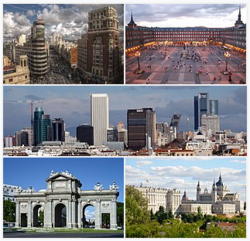Burlon
This article is incomplete because it is pending further input from participants, or it is a work-in-progress by one author. Please comment on this article's talk page to share your input, comments and questions. Note: To contribute to this article, you may need to seek help from the author(s) of this page. |
Burlon
Burlão | |
|---|---|
Capital city and municipality | |
 From upper left: Grande Visão, Plaza Mayor, business districts of CDHP and TDBA, Porta de Arvoredo; and Vidaveira Palace, Deitara Cathedral | |
| Motto(s): "As planícies de Cavela em que vivemos e as planícies em que permanecemos" ("The plains of Cavale we live in and the plains we thrive in") | |
| Country | |
| Settled | 9th century CE |
| Government | |
| • Type | City |
| • Mayor | Lourenço Rego |
| Population (2018) | |
| • Capital city and municipality | 3,223,334 |
| • Urban | 5,596,893 |
| • Metro | 5,946,071 |
Burlon (Produese: Burlão) is the capital and most populous city of Produzland. The city has almost 3.3 million inhabitants and a metropolitan area population of approximately 5.9 million. Burlon lies on the River Seratones in the centre of both the country and the State of Burlon (which comprises the city of Burlon, its conurbation and extended suburbs and villages); this community is bordered by the states of Cavale and Cavale-As Vega. As the capital city of Produzland, seat of government, and residence of the Produese monarch, Burlon is also the political, economic and cultural centre of the country. The current mayor is Lourenço Fernando Rego from the Yellow Party.
While Burlon possesses modern infrastructure, it has preserved the look and feel of many of its historic neighbourhoods and streets. Its landmarks include the Plaza Mayor, the Vidaveira Palace; the Royal Theatre with its restored 1850 Opera House; the Bom Lugar Park, founded in 1631; the 19th-century National Library building (founded in 1712) containing some of Produzland's historical archives; many national museums, and the Golden Triangle of Art, located along the Praça da Passagem and comprising three art museums: Prado Museum, the Rainha Lucía Museum, a museum of modern art, and the Contraforte Voador Museum, which complements the holdings of the other two museums. Perdido Palace and Fountain have become one of the monument symbols of the city.

